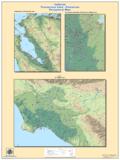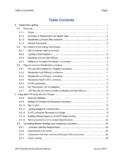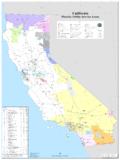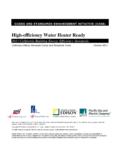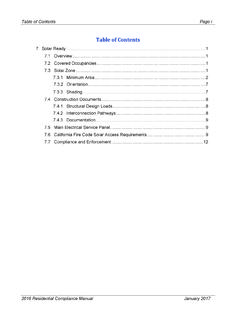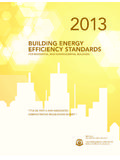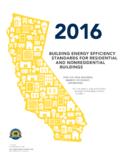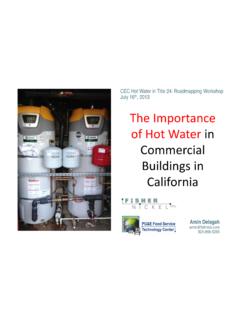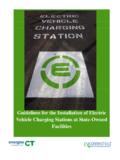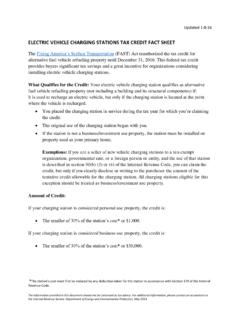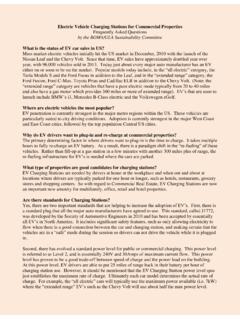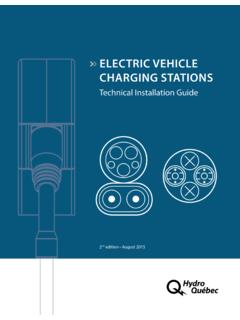Transcription of Tracking Progress - Zero-Emission Vehicles and …
1 California Energy Commission Tracking Progress Last updated 7/5/2017 Zero-Emission vehicle and Infrastructure 1 Zero-Emission Vehicles and Infrastructure In his 2015 inaugural speech, Governor Edmund G. Brown Jr. put forward a goal to reduce today's petroleum use in cars and trucks by up to 50 percent by 2030. This was part o f his strategy to reduce greenhouse gas (GHG) emissions 40 percent below 1990 levels by 2030 as directed in Executive Order B-30-15. On September 8, 2016, Governor Brown signed Senate Bill 32 (Pavley, Chapter 249, Statutes of 2016), putting into law a statewide goal to reduce GHG emissions 40 percent below 1990 levels by 2030. With transportation accounting for about 37 percent of California s GHG emissions in 2014,1 transforming California s transportation system away from gasoline to Zero-Emission Vehicles is fundamental to the state s efforts to reduce GHG emissions . On March 23, 2012, Governor Brown issued Executive Order B-16-2012 to encourage ZEVs in California and set a long-term goal of reaching million ZEVs on California s roadways by 2025.
2 The executive order established milestones for three periods: By 2015, California s major metropolitan areas will be able to accommodate ZEVsthrough infrastructure plans. By 2020, California s ZEV infrastructure will be able to support up to 1 million Vehicles . By 2025, million ZEVs will be on California s roadways with easy access Advancement Zero-Emission Vehicles (ZEVs) plug-in electric Vehicles (PEVs)2 and fuel cell electric Vehicles (FCEVs) continue to need investments in front-loading the charging and refueling infrastructure to support new vehicle rollouts, technological advancements in battery capacity and vehicle range, increased power capacities of fast chargers, and advancements in producing and dispensing hydrogen fuel. In addition to Executive Order B-16-2012, the following provide guidance to the Energy Commission and collaborative statewide efforts in t he advancement of ZEVs and supporting infrastructure: Governor s 2016 ZEV Action Plan3 Released to the public in mid-October 2016, the updated 2016 ZEV Action Plan outlinesprogress to date and identifies new actions state agencies will take in continued pursuitof the milestones in the Governor s executive 2016 ZEV Action Plan highlights the following priorities for ZEVs:1 California Air Resources Board, GHG Emission Inventory 2016 Edition, 2 Includes battery electric Vehicles (BEVs) and plug-in hybrid electric (PHEVs).
3 3 California Energy Commission Tracking Progress Last updated 7/5/2017 Zero-Emission vehicle and Infrastructure 2 oRaising consumer awareness and education about ZEVsoEnsuring ZEVs are accessible to a broad range of CaliforniansoMaking ZEV technologies commercially viable in targeted applications the medium-duty, heavy-duty, and freight sectorsoAiding ZEV market growth beyond CaliforniaThe 2016 ZEV Action Plan introduces new actions to meet these priorities and build California s ZEV market, remove barriers to future market growth, and ensure this transition benefits the state and its residents. The intent is to clearly communicate what state government will do to advance ZEVs and serve as a to-do list for the Governor s Office and state agencies to enhance interagency coordination. The Energy Commission has been tasked in various lead and supporting roles within the 2016 ZEV Action Plan. For public Tracking , staff is developing an informational dashboard Web page for the Energy Commission s activities on the action plan.
4 California Sustainable Freight Action Plan4 Governor Brown s Executive Order B-32-15 directed the Secretary of California StateTransportation Agency (CALSTA), Secretary of the California Environmental ProtectionAgency (CalEPA), and the Secretary of the Natural Resources Agency to lead otherrelevant state departments in developing an integrated action plan by July 2016 that establishes clear targets to improve freight efficiency, transition to zero -emissiontechnologies, and increase competitiveness of California s freight system. Theparticipating state departments are the California Air Resources Board (CARB),California Department of Transportation (Caltrans), Energy Commission, and theGovernor s Office of Business and Economic Development (GO-Biz).This action plan will serve to coordinate state agency priorities and timing on actions toinfluence freight transportation and energy infrastructure, vehicle and equipmenttechnologies, and facility and operations efficiency, rather than the traditional andseparate planning efforts for transportation, environment, and energy.
5 The action planincludes recommendations on:oA long-term 2050 vision and guiding principles for California s future freighttransport for 2030 to guide the state toward meeting the to leverage state freight transport system to initiate over the next five years to advance toward the targets and California Energy Commission Tracking Progress Last updated 7/5/2017 Zero-Emission vehicle and Infrastructure 3 oPilot projects to achieve on-the-ground Progress in the near concepts for further exploration and development, if viable. Senate Bill 350 (De Le n, Chapter 547, Statutes of 2015) Clean Energy and PollutionReduction ActSB 350 increases California s renewable electricity procurement goal from 33 percent by2020 to 50 percent by 2030. Further, SB 350 requires a doubling of statewide energyefficiency savings in electricity and natural gas end uses by 2030. To help ensure thesegoals are met and the GHG emission reductions are realized, specified load-servingentities are required to develop integrated resource plans (IRPs).
6 These IRPs will detailhow each entity will meet their customers resource needs, reduce GHG emissions , andramp up the deployment of clean energy 350 requires California s publicly owned utilities (POUs) with annual electricitydemand exceeding 700 gigawatt-hours to develop and adopt IRPs by January 1, IRPs must discuss how each POU plans to meet GHG reduction targets establishedby the ARB and identify procurement plans of at least 50 percent renewable energyresources by 2030. SB 350 requires that the POU IRPs also address their procurementplans for electrification of the transportation sector within their service territory. The IRPsmust be submitted to the Energy Commission to review for consistency with thelegislative requirements. To expedite review of the IRPs, SB 350 authorizes the EnergyCommission to adopt guidelines that will provide a framework for the information anddata to be submitted by POUs. Volkswagen Settlement California ZEV Investments5 Appendix C of the consent decree (the ZEV Investment Commitment) requires VW toinvest $800 million in ZEV projects in California over a 10-year period.
7 Eligible projectsinclude installing ZEV fueling infrastructure (for both electric - and hydrogen-poweredcars), funding brand-neutral consumer awareness campaigns that will help grow theZEV vehicle market, and investing in projects such as car-sharing programs that willincrease access to ZEVs for all consumers in California, including those in lower-incomeand disadvantaged communities. These projects will support the next generation ofCalifornia ZEVs, helping grow the state s burgeoning ZEV program and laying thefoundation for achieving the state s air quality and climate change goals. ARB s Midterm Review of the Advanced Clean Cars Program6In 2012, the CARB adopted the Advanced Clean Cars (ACC) program, a comprehensiveset of standards for new Vehicles in California through model year 2025. The5 6 California Energy Commission Tracking Progress Last updated 7/5/2017 Zero-Emission vehicle and Infrastructure 4 components of the ACC program are the Low-Emission vehicle III (LEV III) regulations that reduce criteria pollutants and GHG emissions from light- and medium-duty Vehicles for model years 2015 through 2025 and the ZEV regulation, which acts as the focused technology-forcing piece of the ACC program by requiring manufacturers to produce increasing numbers of ZEVs (battery- electric including plug-in hybrids [PHEVs] and fuel cell electric Vehicles ) in the 2018 through 2025 model years.
8 A significant part of CARB s January 2017 Midterm Review focused on Progress in technology since the original analysis and adoption of the standards in 2012. Advancements have already occurred in the vehicle and engine technologies being introduced by vehicle manufacturers to reduce GHG and criteria pollutant emissions , including particulate matter. ZEV technology has also seen significant development that, in many cases, is beyond what was envisioned just four years ago. Below are highlights in ZEV advancements: oThrough May 2017, nearly 300,000 ZEVs and PHEVs have been sold inCalifornia. This contributes toward the more than 600,000 ZEVs and PHEVs inthe United States and the expected 2 million ZEVs and PHEVs around the worldby year s technology has improved, and battery costs (as well as other componentcosts) have fallen dramatically (largely due to reduced material costs,manufacturing improvements, and higher manufacturing volumes), leading to anincrease from 25 PHEV and BEV models offered today to manufacturerannouncements of more than 70 models to be released over the next five electric infrastructure in California has grown with substantial investments inthe past several years, and accelerated investments are expected as newinfrastructure developments emerge.
9 More than 10,000 Level 27 and 1,500 directcurrent fast charger (DCFC) connectors have been deployed across California. oCalifornia s current programs enabled by important legislation (most prominentlyAssembly Bill 8 [ Perea, Chapter 401, Statutes of 2013]) are launching the firstmajor FCEV market and hydrogen fueling network in the United States. ThreeFCEVs are for sale in California, while 28 retail hydrogen refueling stations areopen in California with an additional 32 stations proposed or already indevelopment. Toyota and Honda have also announced partnerships with privatecompanies for financial support of additional stations in California and Level 2 chargers use 208/240 volts, up to kW (80 amps), whereas Level 1 chargers use 110/120 volts, to kW (12 to 16 amps). California Energy Commission Tracking Progress Last updated 7/5/2017 Zero-Emission vehicle and Infrastructure 5 The aforementioned provided additional strategic framework for the Energy Commission s Alternative and Renewable Fuels and vehicle Technology Program investments.
10 Alternative and Renewable Fuel and vehicle Technology Program (ARFVTP) The California Legislature passed Assembly Bill 118 (N ez, Chapter 750, Statutes of 2007) that created the ARFVTP, administered by the Energy Commission. With funds collected from vehicle and vessel registration, vehicle identification plates, and smog-abatement fees, the ARFVTP provides up to $100 million per year for projects that will "transform California s fuel and vehicle types to help attain the state s climate change policies." The statute also calls for the Energy Commission to develop and deploy technology and alternative and renewable fuels in the marketplace, without adopting any one preferred fuel or technology. Assembly Bill 8 (Perea, Chapter 401, Statutes of 2013) subsequently extended the collection of fees that support the ARFVTP through January 1, 2024. As part of the ARFVTP, the Energy Commission prepares and adopts an annual investment plan update that identifies the funding priorities for the coming fiscal year.
